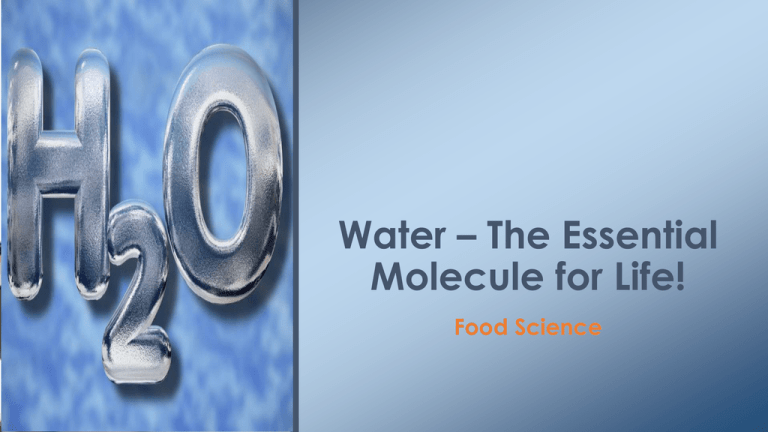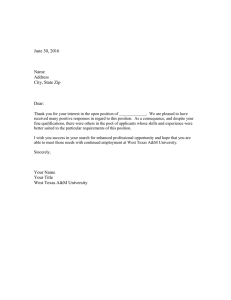
Water – The Essential
Molecule for Life!
Food Science
Copyright
Copyright © Texas Education Agency, 2015. These Materials are copyrighted © and trademarked ™ as the
property of the Texas Education Agency (TEA) and may not be reproduced without the express written permission
of TEA, except under the following conditions:
1) Texas public school districts, charter schools, and Education Service Centers may reproduce and use copies
of the Materials and Related Materials for the districts’ and schools’ educational use without obtaining
permission from TEA.
2) Residents of the state of Texas may reproduce and use copies of the Materials and Related Materials for
individual personal use only, without obtaining written permission of TEA.
3) Any portion reproduced must be reproduced in its entirety and remain unedited, unaltered and unchanged
in any way.
4) No monetary charge can be made for the reproduced materials or any document containing them;
however, a reasonable charge to cover only the cost of reproduction and distribution may be charged.
Private entities or persons located in Texas that are not Texas public school districts, Texas Education Service
Centers, or Texas charter schools or any entity, whether public or private, educational or non-educational, located
outside the state of Texas MUST obtain written approval from TEA and will be required to enter into a license
agreement that may involve the payment of a licensing fee or a royalty.
For information contact: Office of Copyrights, Trademarks, License Agreements, and Royalties, Texas Education
Agency, 1701 N. Congress Ave., Austin, TX 78701-1494; phone 512-463-7004; email: copyrights@tea.state.tx.us.
Copyright © Texas Education Agency, 2015. All rights reserved.
2
H2O
Copyright © Texas Education Agency, 2015. All rights reserved.
3
Properties of Water
1. A chemical compound of
one oxygen an two
hydrogen atoms
2. Small compound held
together by covalent bonds
3. Hydrogen is slightly positive
and oxygen is slightly
negative
4. Commonly referred to as
H2O
Copyright © Texas Education Agency, 2015. All rights reserved.
4
Covalent Bonds
Oxygen and hydrogen share
electrons
• Hydrogen is slightly positive
• Oxygen is slightly negative
• Oxygen is more
electronegative than
hydrogen
• This makes water a polar
molecule
– Opposite electrical charges
Copyright © Texas Education Agency, 2015. All rights reserved.
5
Hydrogen Bonds
• Bonds between molecules
are much weaker
• But stronger than any force
between nonpolar molecules
• Water is a polar molecule so
the hydrogen bonds are
strong
Copyright © Texas Education Agency, 2015. All rights reserved.
6
Hard vs. Soft Water
Hard Water
Soft Water
Contains calcium or magnesium ions
Does not contain calcium or
magnesium
• Can affect the quality of food
prepared in it
• Dishes washed in a dishwasher may
have water spots
• Water with bicarbonate ions may
be softened by boiling it
• Does not dissolve soap as
effectively
• Water with sulfates must pass
through an ion exchange filter to
remove calcium or magnesium ions
• Interferes with water’s tenderizing
effect
• Water softener appliances may be
used in hard water areas
• Laundry tends to have a grayish film
Copyright © Texas Education Agency, 2015. All rights reserved.
7
Heat of Fusion
• To melt ice, heat is required
• 80 calories of heat energy is
needed to change 1.0 gram
of water from solid to liquid
• 80 calories of heat energy are
released for every 1.0 grams
of liquid water that freezes
Copyright © Texas Education Agency, 2015. All rights reserved.
8
Heat of Vaporization
• To boil water, more energy is
needed to break ALL of the
hydrogen bonds
• 540 calories per gram to
change 1.0 gram of water
from liquid to steam
• The gas turns to steam and
can be more dangerous than
boiling water
Copyright © Texas Education Agency, 2015. All rights reserved.
9
Water in Food Preparation
Copyright © Texas Education Agency, 2015. All rights reserved.
10
Functions
• Necessary for forming food
mixtures
• Transfers heat
Copyright © Texas Education Agency, 2015. All rights reserved.
11
Food Mixtures
• Gases, liquids and solids can
be found in water solutions
• Examples:
– Gases – carbonated beverages
– Liquids – vinegar for pickled
foods
– Solids – salt and sugar; tea and
coffee
Copyright © Texas Education Agency, 2015. All rights reserved.
12
Heat Transfers
• Leavening agent
• Steam cooking
– More flavorful
– More nutritious
Copyright © Texas Education Agency, 2015. All rights reserved.
13
Water in the Body
Copyright © Texas Education Agency, 2015. All rights reserved.
14
Functions
1. Maintains body temperature
2. Transports nutrients
3. Serves as a reactant in
metabolism
4. Becomes part of body tissue
Copyright © Texas Education Agency, 2015. All rights reserved.
15
Hydration
• Most people need six to eight
glasses of water a day
• The body gets the water it
needs from:
– Beverages
– Foods you eat
Water has no calories
Copyright © Texas Education Agency, 2015. All rights reserved.
16
Thirst
• A feeling that lets your body
know it needs water
• By that time, your water
supply is already low.
• Consume water throughout
the day before you become
thirsty.
Copyright © Texas Education Agency, 2015. All rights reserved.
17
Lack of Water
Can:
• Begin to damage body tissue
• Lower energy levels
• Reduce coordination
Copyright © Texas Education Agency, 2015. All rights reserved.
18
The Properties of Water
(click on link)
(image from video)
Copyright © Texas Education Agency, 2015. All rights reserved.
19
Copyright © Texas Education Agency, 2015. All rights reserved.
20
Let’s Review!
1. How much of the earth’s surface is water?
2. What is a covalent bond? What is a hydrogen bond?
3. What is the difference between hard and soft water?
4. What is an example of heat fusion? Heat vaporization?
5. How many calories does water have?
6. How is water used in food?
7. What are the four functions of water in the body?
8. How can you tell when you are thirsty?
Copyright © Texas Education Agency, 2015. All rights reserved.
21
Copyright © Texas Education Agency, 2015. All rights reserved.
22
References and Resources
Images:
•
Shutterstock™ images. Photos obtained with subscription. (Slides 1, 3, 4, 5, 6, 8, 9, 10, 11, 12, 13, 14, 15, 16, 17, 18, 20, 21)
Textbooks:
•
Mehas, K. Y. & Rodgers, S. L. (2002). Food science: The biochemistry of food and nutrition. New York, NY: Glencoe/McGraw-Hill.
•
Ward, J. D. & Ward, L. T. (2015). Principles of food science. Tinley Park, IL: Goodheart-Willcox Company.
Websites:
•
Environmental Protection Agency
Water: Drinking Water - For Teachers (Grades 9-12)
http://water.epa.gov/learn/kids/drinkingwater/teachers_9-12.cfm
•
Science Buddies Staff. (2015, March 20).
Chemistry of Ice-Cream Making: Lowering the Freezing Point of Water.
Retrieved May 21, 2015 from http://www.sciencebuddies.org/science-fair-projects/project_ideas/FoodSci_p013.shtml
•
Science Buddies Staff. (2014, October 3).
Investigating the 'Mpemba Effect': Can Hot Water Freeze Faster than Cold Water?
Retrieved May 21, 2015 from http://www.sciencebuddies.org/science-fair-projects/project_ideas/Phys_p032.shtml
•
Science Buddies Staff. (2014, October 6).
Saturated Solutions: Measuring Solubility.
Retrieved May 21, 2015 from http://www.sciencebuddies.org/science-fair-projects/project_ideas/Chem_p050.shtml
•
Science Buddies Staff. (2014, November 18).
Electrolyte Challenge: Orange Juice Vs. Sports Drink.
Retrieved May 21, 2015 from http://www.sciencebuddies.org/science-fair-projects/project_ideas/Chem_p053.shtml
Copyright © Texas Education Agency, 2015. All rights reserved.
23
References and Resources
Websites:
•
The USGS Water Science School
Water Properties - Facts and Figures About Water
http://water.usgs.gov/edu/water-facts.html
YouTube™:
•
The Properties of Water
This four minute animation describes the properties of water that support life. These properties include solvency, cohesion and
adhesion, high surface temperature, high heat capacity, high heat of vaporization and varying density.
https://www.youtube.com/watch?v=aVmU3CLxvgU
24

